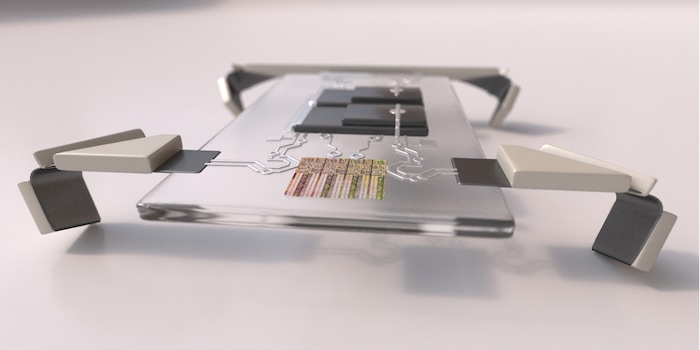
Lasers give microrobots a leg up
Microrobots have not been very effective so far. A US team has now developed robotic wrigglers with a laser-controlled locomotion system that are no bigger than paramecia.
They bend and stretch like little flippers: Researchers led by physicist Marc Miskin have created little legs with which micro-robots can crawl over a water-covered surface. The so-called actuators are driven and controlled by laser beams. As the team from Cornell University and the University of Pennsylvania reports in the scientific journal "Nature", these are the first known robots less than 0.1 millimetres in length whose movement is controlled by on-board electronics using laser propulsion.
The electrochemical actuators convert electric current into force by allowing the ions of the surrounding liquid to accumulate on the surface and thus change the voltage in the leg, causing it to bend or stretch. The mechanism is set in motion by a laser beam: Using photovoltaic patches on the robot's body, it can control the front and rear legs separately.
The researchers produced the actuators using the same nanotechnologies that are used in computer chips. For the prototype microrobot, they wired the four actuators to a series of solar cells on the central housing. Using this method, they could place more than a million robots on a disc about the size of a palm - a step towards the mass production of silicon-based robots that cannot be seen with the naked eye.
At the moment, however, their function is still limited: They swim more slowly than other microrobots and have neither environmental sensors nor autonomous internal control. However, they can be easily connected to known microelectronics, for example to process sensory input. They could also withstand an acidic environment and temperature fluctuations of more than 70 degrees Celsius.
Miskin and his colleagues have thus presented a new design concept, comment engineers Allan Brooks and Michael Strano from the Massachusetts Institute of Technology in Boston in "Nature". The central processing unit and legs could be manufactured simultaneously and the actuators could be powered by the same current as electrical circuits and sensors. Similar other microrobots would be far less efficient.
Brooks and Strano categorise the new remote-controlled microrobots as "puppets": they do not require an on-board power source and control system, but do need external support. Fully autonomous devices would not need this, but it is questionable whether they can be miniaturised. Miskin and his colleagues have offered a solution: equipping their robots with a battery. According to Brooks and Strano, this would be a further step towards a vision by Richard Feynman: in 1959, the future Nobel Prize winner in Physics proposed "swallowing a surgeon", a tiny robot that would travel through the body via the bloodstream and operate where necessary.
Spectrum of Science
We are partners of Spektrum der Wissenschaft and want to make well-founded information more accessible to you. Follow Spektrum der Wissenschaft if you like the articles.
[[small:]]
Experts from science and research report on the latest findings in their fields – competent, authentic and comprehensible.